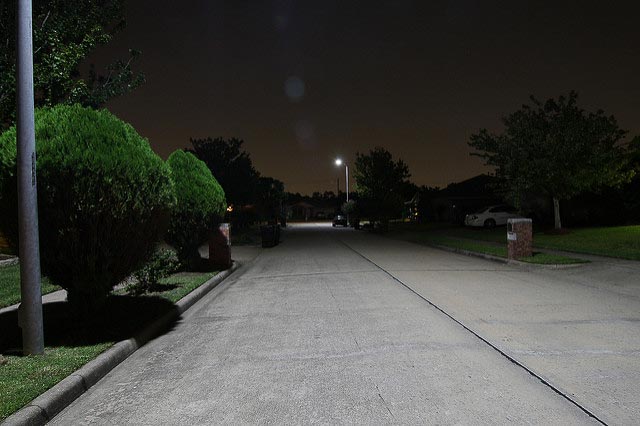Streetlights seem like they should be a benign topic. They're unremarkable, familiar fixtures that are part of the backdrop of everyday urban life. But lately, they've been a contentious topic for some Houstonians.
Two years ago, the city began the process of switching all 173,000-plus of its streetlights from sodium bulbs (with their familiar, yellow glow) to LEDs, which emit a whiter and often brighter light.
Today, Houston is roughly halfway through that process. And a cadre of some critics have voiced opposition to the switch, mainly due to dissatisfaction with the brightness of the new bulbs. That's a whole debate that the Kinder Institute won't be weighing in on. But it does raise an intersting point: for some residents, brighter light isn't always seen as a good thing.
In the Kinder Institute's newest study, research fellow Dr. Heather O'Connell analyzes the location of Houston's streetlights to determine which areas have the highest concentration of street lights and which have the lowest. It's an important question because for many, street lights are a critical amenity. They make residents feel safer and more comfortable. But on the other hand, they can be considered a nuisance, at least by some, or even a tool for surveillance.
O'Connell's study -- the full version of which is available at kinder.rice.edu -- offers several fascinating findings.
In Houston, each census block group has an average of 15 streetlights per mile of roadway. But there's huge variation within the city. Some areas have 1 streetlight per mile or less. Others have as many as 47. So O'Connell tried to determine which areas had the most streetlights, and which had the least.
Article continues below the map of Harris County.
 Map of streetlight concentration in Harris County, Texas.
Map of streetlight concentration in Harris County, Texas.Source: Kinder Institute for Urban Research.
She found that predominantly white neighborhoods, on average, have lower concentrations of streetlights than black or Hispanic neighborhoods. The trend, she writes, is "consistent with a surveillance perspective regarding the placement of streetlights."
O'Connell also found two other trends, related to the intersection of streetlights and income, that at first glance may appear to contradict each other.
She found a close relationship between the concentration of streetlights in an area and the median income of an area. In other words, as average incomes of a community rise, so too does the number of streetlights per mile of roadway. But she also found that neighborhoods with higher poverty rates also have more streetlights per mile.
How do those findings align? O'Connell says what's really happening is that streetlights are most common in economically mixed neighborhoods. Streetlights aren't equally prevalent in neighborhoods with the same median income, if they have different poverty levels. Residents can request that the city conduct surveys of an area to determine whether it needs more lighting. O'Connell suggests that maybe more requests for streetlight surveys are made in areas where both median income and poverty levels are high.
But, more broadly, what does it all mean? What should we take away from the fact that there are wide variations in streetlight concentration, and those variations follow a very specific set of patterns?
On one hand, minority and high-poverty neighborhoods have some of the highest level of streetlight density in Houston. They are not being denied important infrastructure, which is a good thing. But we also know that more light isn't always seen as a positive by residents. O'Connell concludes:
"We should consider the possibility that some areas of the city are overly lit in addition to being concerned about the places without enough lights. If it is true that some residents prefer moderate levels of lighting, then this could help explain some of the initially counterintuitive results. The relative influence or power of certain neighborhoods may explain why certain areas have fewer, but not too few, streetlights, especially when considering non-Hispanic white and higher income neighborhoods."
In other words, sometimes streetlights may be seen as amenities; but other times, too many can be perceived as a nuisance. Either way, O'Connell writes, strong communication about the role of streetlights is needed, given the impact they have on urban life.


